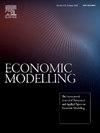Firm-level analysis of bubble formation in Chinese real estate equities
IF 4.7
2区 经济学
Q1 ECONOMICS
引用次数: 0
Abstract
This study investigates evidence of bubble preponderance in China's real estate sector and seeks to identify the main determinants of exuberance in the equity prices of listed developers, relative to their dividend-based fundamentals. In contrast to the focus on property prices and rents that characterizes prior research, we emphasize real estate equity prices and firm-specific metrics. This shift in perspective, and the corresponding use of a dividend-based proxy, separates speculative-driven bubbles from those linked to fundamentals and thus enables us to better interpret the nature of exuberance as well as assess the alignment—or misalignment—between prices and fundamentals. Our empirical examination, based on the equity prices of 25 publicly listed developers included in the BICHODVP Chinese benchmark real estate index, detects bubbles in developer equity prices as well as the presence of common bubble dynamics among BICHODVP index components. Additionally, by incorporating firm-specific characteristics and macroeconomic variables, we provide a more granular understanding of how company characteristics—especially corporate valuation multiples and leverage—interact with broader market and policy conditions to generate equity price bubbles in the real estate sector.
中国房地产股票泡沫形成的企业层面分析
本研究调查了中国房地产行业泡沫优势的证据,并试图确定上市开发商股票价格繁荣的主要决定因素,相对于他们基于股息的基本面。与之前研究的重点是房地产价格和租金不同,我们强调房地产股票价格和公司特定指标。这种观点的转变,以及对基于股息的代理的相应使用,将投机驱动的泡沫从与基本面相关的泡沫中分离出来,从而使我们能够更好地解释繁荣的本质,并评估价格与基本面之间的一致性或不一致性。我们基于BICHODVP中国基准房地产指数中包含的25家上市开发商的股票价格进行实证检验,发现开发商股票价格存在泡沫,以及BICHODVP指数组成部分之间存在共同的泡沫动态。此外,通过整合公司特定特征和宏观经济变量,我们更细致地了解了公司特征——尤其是公司估值倍数和杠杆率——如何与更广泛的市场和政策条件相互作用,从而在房地产行业产生股票价格泡沫。
本文章由计算机程序翻译,如有差异,请以英文原文为准。
求助全文
约1分钟内获得全文
求助全文
来源期刊

Economic Modelling
ECONOMICS-
CiteScore
8.00
自引率
10.60%
发文量
295
期刊介绍:
Economic Modelling fills a major gap in the economics literature, providing a single source of both theoretical and applied papers on economic modelling. The journal prime objective is to provide an international review of the state-of-the-art in economic modelling. Economic Modelling publishes the complete versions of many large-scale models of industrially advanced economies which have been developed for policy analysis. Examples are the Bank of England Model and the US Federal Reserve Board Model which had hitherto been unpublished. As individual models are revised and updated, the journal publishes subsequent papers dealing with these revisions, so keeping its readers as up to date as possible.
 求助内容:
求助内容: 应助结果提醒方式:
应助结果提醒方式:


